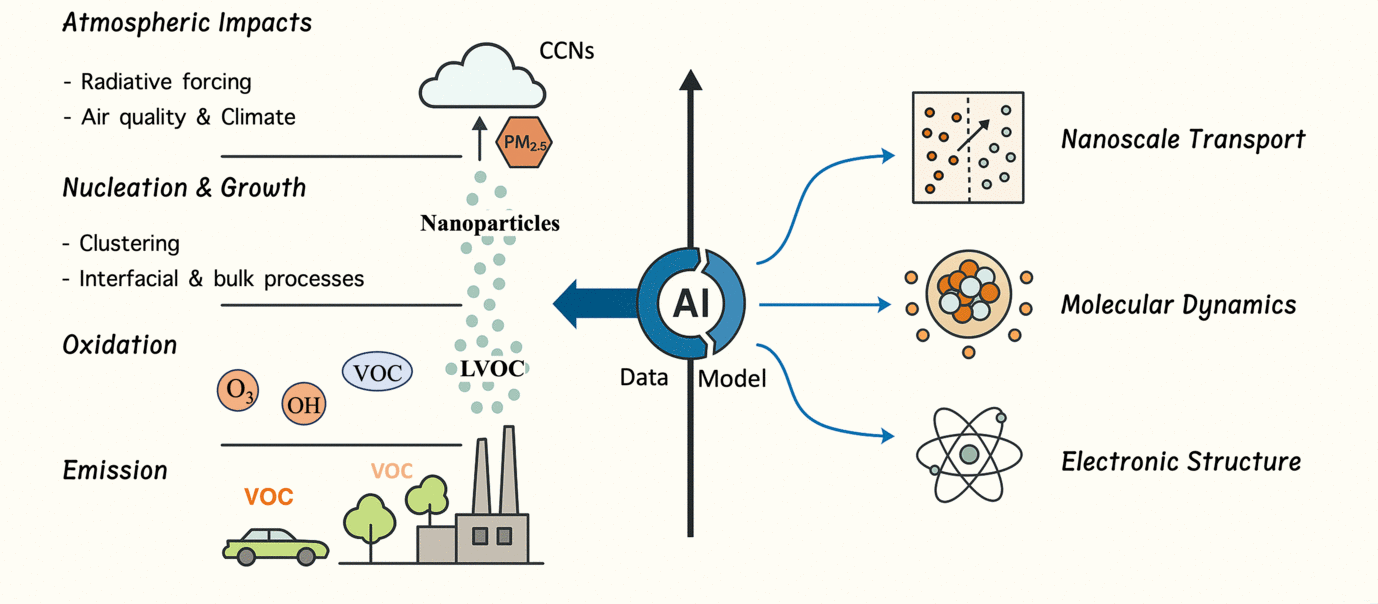Nanoscale theory and modeling
Dr. Huan Yang, Project Team Leader
Research Overview
The conversion of gaseous precursors to condensed-phase aerosol particles is a nanoscale phenomenon with profound global impacts. These conversion processes occur continuously and ubiquitously throughout Earth’s atmosphere, shaping quality of life in multifaceted ways: they influence climate by serving as cloud condensation nuclei (CCN) and influence air quality through the formation of particulate matter (PM). A typical neutral aerosol formation pathway involves three major stages, distinguished by the chemical species involved and their associated physicochemical processes: (1) the oxidation of precursors emitted from biogenic and anthropogenic sources, (2) the nucleation of oxidation products to form stable nuclei, and (3) the subsequent growth of these nuclei into larger particles (through bulk and interfacial processes) capable of influencing climate. Due to the complexity and diversity of species and processes involved, the detailed mechanisms governing atmospheric aerosol formation remain ambiguous.

We develop and apply state‑of‑the‑art molecular‑modelling techniques to probe the molecular and nanoscale phenomena underlying gas‑to‑aerosol particle conversion. Acting as “virtual microscopes,” these tools aim at deciphering the atomistic mechanisms by which gaseous precursors nucleate into clusters and grow into aerosols in the atmosphere.
Key Topics
1. Autonomous, High‑Throughput Calculations for Atmospheric Oxidation Mechanism Generation
Development of automated pipeline that launches and learns from large numbers of quantum‑chemical calculations and enhanced sampling molecular dynamics simulations to chart the oxidation networks of atmospheric volatile organic compounds and pinpoint the low‑volatility products that trigger atmospheric nucleation.
2. AI‑Augmented Molecular Modeling for Atmospheric Nucleation and Interfacial Processes
We develop AI‑augmented molecular modelling techniques that retain quantum‑level accuracy while extending to larger size scales and longer time scales, enabling to probe in silico the molecular birth of atmospheric new particles. Examples include coupling machine‑learned force fields with rare‑event sampling to predict interfacial and bulk phenomena that govern atmospheric aerosol growth and degradation, e.g., nucleation, reactive uptake, particle phase reactions, phase transitions, and nanosize effects.
3. Nanoscale Transport Phenomena Related to Atmospheric Aerosol Processes
We develop theories and models to investigate the nanoscale transport processes associated with gas-to-particle phase transitions, including molecular mass transport resulted from condensation/evaporation or bulk/interfacial reactions, energy transport triggered by non-isothermal events, and momentum transport related to aerosol drag.
